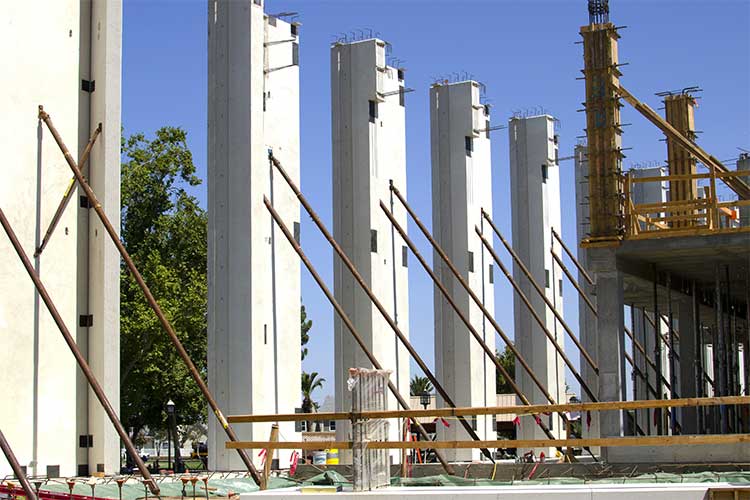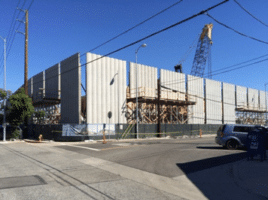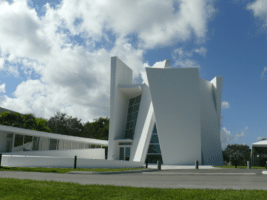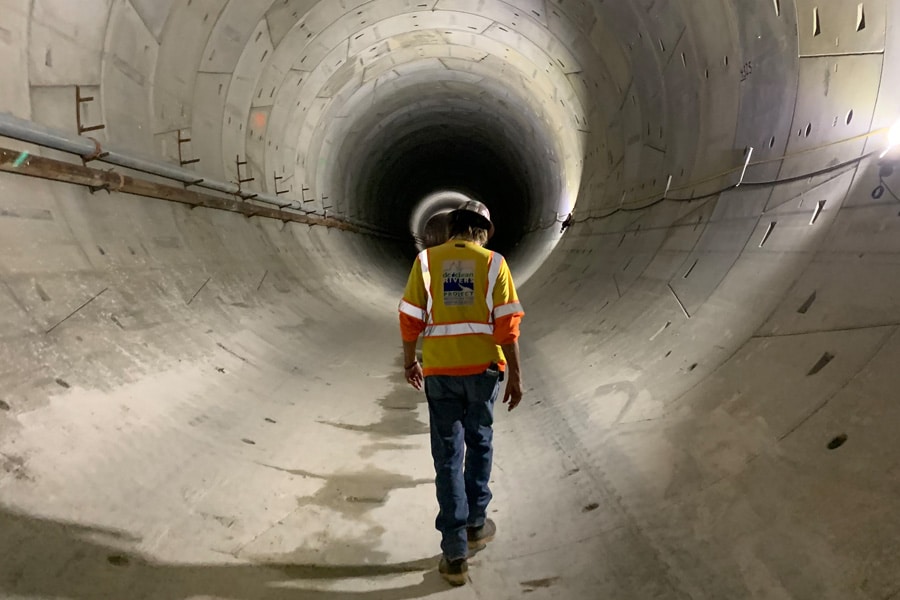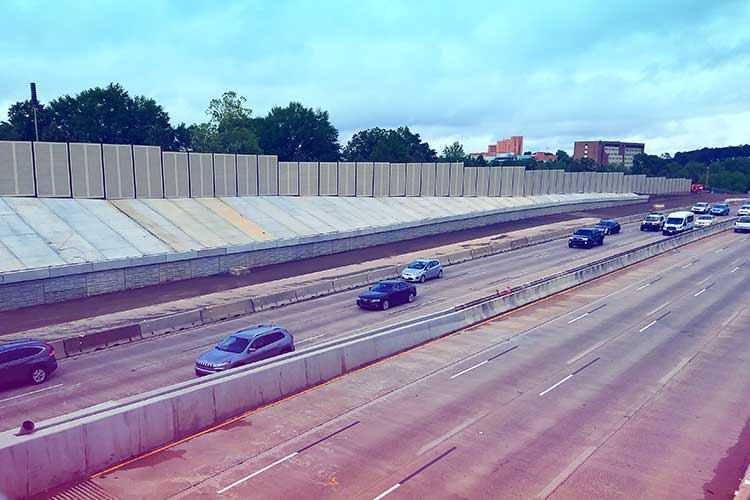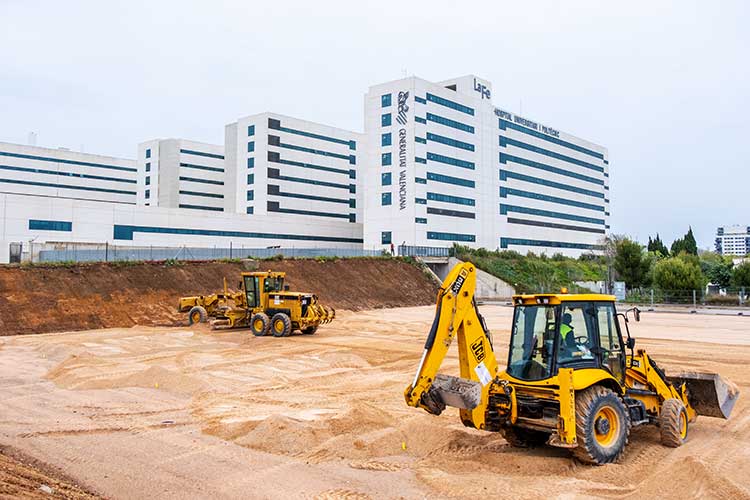Long associated with unsightly, boxy warehouses and squat, suburban office buildings, tilt-up construction is often maligned for a perceived incompatibility with complex, innovative architecture.
But recent projects are challenging that notion. Far beyond utilitarian cubes, these buildings explore the expressive potential of concrete and push boundaries in terms of efficiency, cost savings and sustainability.
Noteworthy among them are visually arresting works such as Newman Architects’ AIA award-winning Snyder Sanctuary in Boca Raton, Florida, and LEED Platinum buildings, such as DWL Architects’ White Tank Branch Library and Nature Center in Arizona.
In use for more than 100 years, primarily in North America, concrete tilt-up construction involves the on-site horizontal casting of large tilt-up concrete panels, which, once cured, are raised into position by cranes to form exterior walls.
According to the nonprofit Tilt-Up Concrete Association (TCA)—which represents architects, engineers, contractors and suppliers and oversees certification and awards programs—there are many benefits to the method.
Chief among them are speed, with typical time from panel formation to completed building shell at four to five weeks; durability and fire resistance; and, perhaps most important, cost effectiveness, as the method uses readily available materials and requires fewer skilled laborers than precast, masonry or steel structures, while eliminating the need for off-site fabrication and transport.
Detractors, meanwhile, note that, in addition to aesthetic, material and height limitations, tilt-up isn’t typically an option for projects in tight urban lots, as the horizontal fabrication of the concrete panels requires significant construction-site space.
Concrete by design
There are, of course, exceptions. Among high-profile recent examples is the UCLA Margo Leavin Graduate Art Studios, designed by architects Johnston Marklee and constructed in 2019 in an industrial area of Culver City, California, far from the open environments often associated with tilt-up.
The 48,000-square-foot project—which encompassed the renovation of a 1930s cast-in-place concrete warehouse building “wrapped” by a new, L-shaped, tilt-up addition—was able to overcome significant site constraints.
“Once we had the contractor, Abbott Construction, on board, that was the first thing that everyone validated, that it could be actually done on-site,” said project architect Lindsay Erickson. “It’s not a typical suburban tilt-up location, so when they started pouring the panels, the entire L-shaped area of the new construction was covered, but they were able to make it work.”
The panels, 30 feet tall and ranging from 14 to 20 feet wide, were poured in a day. “Just because it’s fast doesn’t mean you can’t do some amazing things, specifically with the finish,” Erickson said. The architects devised a panel surface of convex vertical forms, which they refer to as “pillows,” to create texture on the monolithic wall facing the street.
In addition to imparting a sculptural quality that activates the façade through the play of light and shadow, the pillows underscore a strict geometry. Each pillow is 2 feet wide; the panel dimensions were based on that unit of measurement. The panels were lifted into place with 2-foot gaps between them; these were then filled with cast-in-place columns, poured vertically.
Thus, the structural columns, which are attached to the foundation, match the proportions of the pillows for a seamless effect. The tilt-up panels are connected to the columns at the sides but rest on the foundation’s stem wall through gravity alone.
“There were a lot of benefits to doing this project in tilt-up,” Erickson said. “One is we were able to increase the thickness of the walls so that there’s no additional insulation. So, the walls are at minimum 10 inches thick. The other benefit of doing tilt-up over, say, a hung precast panel is that we don’t need any backup structure. So, you’re seeing the back of the concrete panel when you’re inside the building.”
Eliminating drywall on the interior, Erickson said, was a strategic decision made to harmonize the addition with the exposed concrete of the existing 1930s structure and to reference Southern Californian vernacular architecture in general. The bare concrete is also a highly functional choice for an art studio, where walls “tend to get beaten and battered.”
Budget boost
The utility of tilt-up panels was a criterion in the construction of Gensler’s East Campus Medical Office Building at the University of California, San Diego. Tom Heffernan, a principal at Gensler who has served on the TCA board, oversaw the project, which combines textured tilt-up concrete with a sheer curtain wall system.
Tilt-up walls, Heffernan said, have “the ability to be exterior finish, the gravity load-bearing structure, the lateral earthquake- and wind-resistant structure, and, in some cases, the interior finish as well.”
The RFP For UCSD’s design competition for the new building indicated that the school would consider tilt-up construction proposals. Gensler, Heffernan said, “took that as a challenge: ‘Can we do some tilt-up that we’re proud of, and what would that do to benefit the budget?’”
The architects strove to push the potential of concrete. “We were very excited by how sculptural the material could be and wanted to use it in the most honest way possible,” Heffernan said, rather than “trying to hide it behind paint.”
Working with concrete subcontractor Minegar Contracting and general contractor C.W. Driver, the team modified the concrete mix to create light, warm colors and used a variety of form liners to introduce multiple textures. “And then, because it is such a stiff material, we used it to provide shape to building parapets, so it doesn’t look like just a big box.”
But the real driver in the decision to use tilt-up was budget. “What was discretionary was really the skin of the structural frame,” Heffernan said. “So, we said, if we do tilt-up, then we can eliminate the perimeter columns, and we can use a long-span, open-width joist system to support the floors and the roof. That would bring the pounds of steel in the project significantly lower than if it was a conventional steel-framed building.”
The savings this produced allowed the team to inject a glass curtain-wall system at the building’s entry. “If we had used just a conventional steel frame, we would not have been able to afford that premium material at the entrance,” Heffernan said.
The variety of tilt-up construction use cases and design innovation is increasing all the time, added Heffernan, who served for multiple years as a juror on the TCA’s awards program. “Owners get a cast-in-place concrete building and everything that goes with that in terms of durability and value. I think it’s up to designers to be looking for creative ways to use it really expressively.”




